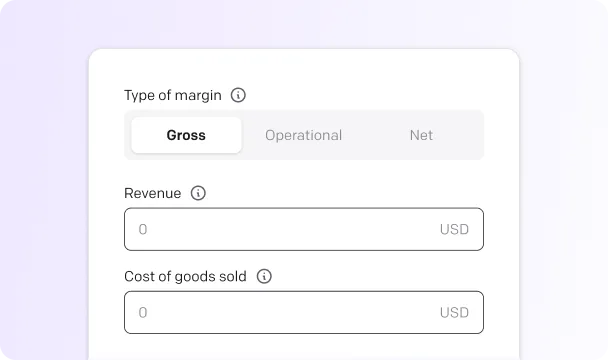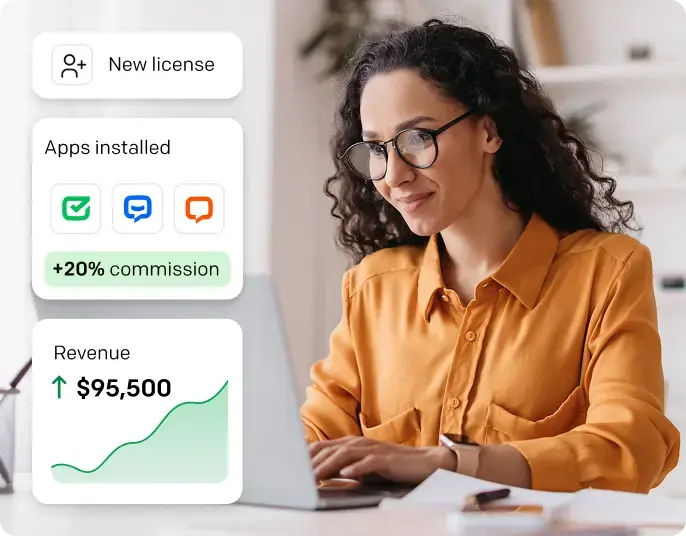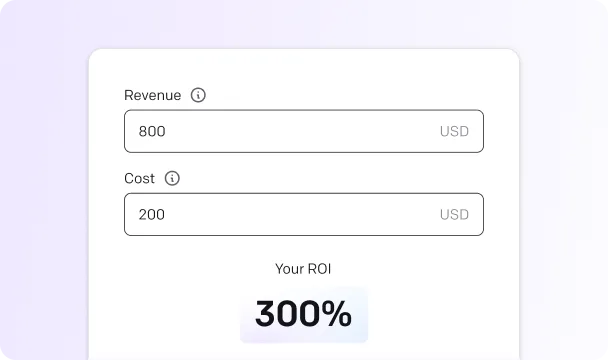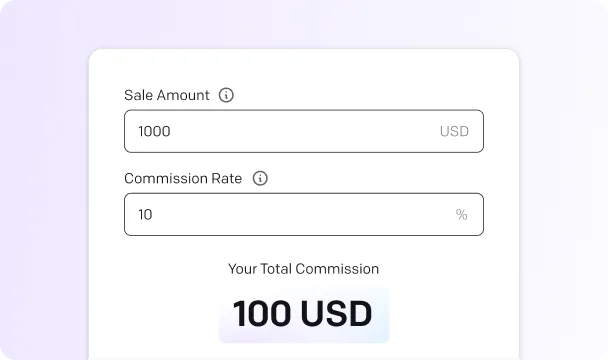Commission Calculator: Track and Boost Your Sales Now
Whether you're a sales pro or just starting out, learn how to track your commissions accurately and uncover ways to boost your income effortlessly.
Commission calculator
Your commission
Table of contents
Do you dread the moment when you have to calculate your commissions?

Let’s face it: commission calculations can quickly become a headache, especially when dealing with varying commission structures, tiered payouts, or performance bonuses.
But here’s the thing: these numbers are more than just your paycheck. They clearly show how well your affiliate strategy works and can help you optimize for even better results.
Here, I'll explain commission calculations in affiliate marketing and show you how to simplify them. I'll explore common commission structures, share formulas, and give you tools to streamline your tracking.
Ready to stop stressing over your earnings?
Let’s dive in and make commission calculations a breeze!
What is a commission?
A commission is like a reward for getting the job done. It’s a payment you earn based on the results you deliver, typically tied to sales or performance.
If you’re in sales, you might earn a percentage of every deal you close. If you’re an affiliate marketer, you could get a cut of each sale coming through your referral link.
In a corporate setting, commissions are all about motivation. If your earnings depend on your performance, you’re naturally more driven to go the extra mile. Companies use commissions as a way to align their goals with yours. When you succeed in selling more products or bringing in new customers, the company benefits, and so do you.
This system isn’t just about money. It’s about creating a sense of ownership in your work. It encourages you to think strategically, build better customer relationships, and find ways to improve your results.
Commissions turn your hard work into tangible rewards, making every sale or referral feel like a personal victory.
Understanding commission structures + calculation formulas
Commission structures determine how you earn based on performance. Companies use these models to reward employees or partners for driving revenue, ensuring fairness while encouraging productivity. Let’s explore the most common types.
| Type | Description | Common Use Case | Pros | Cons |
|---|---|---|---|---|
| Flat-rate commission Calculate | Fixed amount per sale regardless of value | Subscription sales, product-based sales | Simple, predictable | Doesn’t reward high-value sales |
| Percentage-based commission Calculate | Earn a fixed % of each sale | Retail, real estate, B2B sales | Scales with sale size, motivating | Income can be inconsistent |
| Tiered commission Calculate | Higher rates for hitting sales targets | High-performance sales teams | Rewards growth, motivates overachievement | More complex to track and explain |
| Residual/recurring commission Calculate | Ongoing earnings from a client/account over time | SaaS, insurance, membership-based services | Long-term income stream | Depends on client retention |
| Draw against commission Calculate | Advance payment against future commissions | New sales reps or high-risk markets | Offers financial stability early on | Risk of “owing” the company if targets aren’t met |
| Bonus and hybrid structures Calculate | Commission + bonuses or salary + commission | Enterprise sales, corporate roles | Balanced income, performance incentives | Can be hard to structure fairly |
| Gross and net commission Calculate | Based on total sale (gross) or profit margin (net) | Varies by company strategy | Net encourages selling profitable items | Net can demotivate if margins are unclear or small |
Flat-rate commission
Flat-rate commission is the simplest form of commission. You earn a fixed amount for every sale or specific action, regardless of the sale’s size or value.
Flat-rate commission calculator
Your commission
TC - Total commission
NoS - Number of sales
FRS - Flat rate per sale
Example:
If you earn $50 per sale and make 10 sales, your total commission is: 10 × $50 = $500
The flat fee model works best for straightforward sales processes where the products or services have a fixed sale price, such as retail items or subscription plans. It’s easy to understand and predict, making it a favorite for newcomers or simpler commission systems.
Percentage-based commission
This structure ties your commission to the value of the sale. You earn a percentage of the total sales, meaning larger sales bring higher rewards.
Percentage-based commission calculator
Your commission
TC - Total commission
SA - Sale amount
CR - Commission rate
Example:
For a $1,000 sale with a 10% commission rate, your commission is: $1,000 × 0.10 = $100
Percentage-based commissions incentivize higher-value sales and are commonly used in industries like real estate, SaaS, or any business dealing with variable pricing. This model encourages salespeople to prioritize high-ticket items.
Tiered commission
Tiered commissions increase the commission rate as you achieve specific sales milestones. The more you sell, the higher your earnings per sale.
Tiered commission calculator
Your commission
TC - Total commission
ST - Sales in tier
RT - Rate for tier
Example:
For $12,000 in sales with the following tiers:
- Tier 1 - Sales to SMEs (Small & medium-sized enterprise) - $3000 and 5% commission
- Tier 2 - Sales to Enterprises - $9000 and 10% commission
Your calculation would look like this:
- First $3,000: $3,000 × 5% = $150
- Second $9,000: $9,000 × 10% = $900
- Total Commission: $150 + $900 = $1050
This structure is excellent for motivating high performance and rewarding increased productivity. You’ll often find it in industries like SaaS, insurance, or any sales role with scalable goals.
Residual or recurring commission
Residual commissions pay you a percentage of ongoing revenue from customers you’ve acquired, typically from subscriptions or recurring services.
Residual or recurring commission calculator
Your commission
CPP - Commission per period
RP - Recurring payment
CR - Commission rate
Example:
If you refer a customer who pays $100 monthly for a service and your commission rate is 15%, your earnings per month is: $100 × 0.15 = $15
For a year: $15 × 12 = $180
This structure is standard in affiliate marketing or industries focusing on recurring revenue, like software-as-a-service (SaaS). It incentivizes finding long-term customers since the longer they stay, the more you earn.
A great example is of Text Partner Program. It is an excellent opportunity for marketers, content creators, and website owners to earn while promoting industry-leading tools like ChatBot, HelpDesk, and LiveChat.
Affiliates earn up to 22% commission percentage on referred sales, with a generous 120-day cookie duration, ensuring you get credit for sales within four months. The program also provides a custom affiliate link builder, offering longer trials and additional discounts, and a Partner App for tracking performance and optimizing campaigns.
With marketing assets at your fingertips and high-paying commissions, the program offers significant earning potential. Some affiliates have earned over $4,000,000 to date.
Signing up is simple. Start promoting today!
Draw against commission
With a draw against commission, you receive an advance (or “draw”) each period. The draw is a minimum income guarantee, but it’s deducted from your earned commissions.
Draw against commission calculator
Your commission
FP - Final payout
EC - Earned commission
MD - Monthly draw
Example:
If you receive a $1,500 monthly draw and earn $2,000 in commissions for the month, your payout is: $2,000 − $1,500 = $500
If your earned commission is less than $1,500, the company may carry over the difference as a debt to future commissions.
This structure is ideal for sales roles where income can fluctuate, such as B2B sales or real estate agent commission. It provides stability while still allowing high earners to reap the benefits of their performance.
Bonus and hybrid structures
Bonuses or hybrid structures combine multiple commission types or add incentives for achieving targets, like meeting sales quotas or closing high-value deals.
Bonus and hybrid structures calculator
Your commission
TE - Total earnings
BS - Base salary
SA - Sale amount
CR - Commission rate
B - Bonus
Example:
For $10,000 in sales:
- Base Salary: $2,000
- Commission Rate: 8%
- Bonus for exceeding $9,000: $500
Your earnings would be:
- Base Salary: $2,000
- Commission: $10,000 × 8% = $800
- Bonus: $500
- Total Earnings: $2,000 + $800 + $500 = $3,300
Hybrid structures are common in industries with both base salaries and performance-based incentives. They provide a safety net while rewarding exceptional performance.
Here's another real estate example: An experienced real estate agent closes a property sale with a sale price of $500,000. The realtor commission is 6%, split equally between the buyer's agent and the seller's agent.
As the seller's agent, you earn 3%, which is $500,000 × 3% = $15,000. Also, a $1,000 bonus for selling above $450,000 brings your total earnings to $16,000.
Gross and net commission
The gross sales commission is calculated on the total sale amount, while the net commission is based on the final sale price after deductions like discounts, taxes, or refunds.
Gross commission calculator
Your commission
GC - Gross commission
GSA - Gross sale amount
CR - Commission rate
Net commission calculator
Your commission
NC - Net commission
GSA - Gross sale amount
D - Deductions
CR - Commission rate
Example:
For a $1,000 sale with a $100 discount and an 8% commission rate:
- Net Sale Amount: $1,000 - $100 = $900
- Commission: $900 × 8% = $72
Understanding gross vs. net is critical for roles where discounts, returns, or fees impact the final sales value.
text partners
Calculate how much you can earn with LiveChat, ChatBot, and HelpDesk
Turn your referrals into steady, recurring commissions effortlessly. Curious about your earning potential? Use the calculator below and instantly visualize how your earnings can grow month after month. Here’s what your income could look like:
Refer
50 customers
Earn on average $ 46 240 annually
Some of our top affiliates have already earned over $4.75 million with ease.
Ready to see exactly how much passive income you could generate?
Start earning nowExplore our set of text-based tools

Profit Margin Calculator
Instantly check how much you’re really making on each sale.

JSON | CSV Converter
Enjoy best-in-class support to help you succeed — our team is here to assist you and your clients, anytime.

Regex Builder
A regex testing tool lets users debug regular expressions with real-time feedback.

Language Detector
Use free language identifier to detect the language of a text document or file.

Text to Speech Generator
Convert text to speech online to enjoy natural-sounding voices and high-quality audio files.
How to maximize your commission earnings
If you want to make the most of your commission-based role, you need more than just effort. A strategy is a must with smart planning and execution.
1. Understand the commission structure
The first step to earning more is understanding how your commission plan works. Do you get a flat rate or a percentage of the sale? Are there bonuses for hitting milestones? Familiarize yourself with the specifics, including tiers, deductions, and payment schedules.
Knowing your commission structure inside and out lets you identify opportunities to earn more. For example, if there’s a tiered system, you can push harder to hit higher brackets. Clear understanding ensures you’re not leaving money on the table.
2. Track your sales
Consistent tracking of your sales is a game-changer. Whether you use a CRM system, spreadsheets, or specialized commission-tracking software, keeping a detailed record helps you monitor your progress and set realistic goals.
You can focus your efforts strategically to close those extra deals by tracking. Plus, it helps you identify trends, like which products or services bring the highest commissions.
3. Negotiate commission rates
If you’ve consistently hit targets or exceeded expectations, don’t hesitate to negotiate for better terms. Higher rates can make a huge difference for experienced professionals, especially those in fields like real estate or SaaS sales.
To do so:
- Build a case: Show your performance data, highlighting your contributions to revenue.
- Propose a solution: Suggest a win-win structure, like a higher percentage or additional bonuses for hitting stretch goals.
- Choose the right time: Negotiations are often most successful during performance reviews or when you’ve just achieved a significant milestone.
4. Improve sales performance
Boosting your sales is the most direct way to increase commission earnings. Here are a few strategies:
- Upsell and cross-sell: Suggest complementary products or upgrades to increase the sale value.
- Focus on high-ticket items: Prioritize products or services that offer higher commission rates.
- Expand your customer base: Cultivate relationships with new clients and follow up with past customers to generate repeat business.
Example: Focusing on luxury properties with higher sale prices can significantly increase your realtor commission if you're a real estate agent.
Also, utilize tools to save time, reduce errors, and stay organized. With a clear picture of your earnings and performance, you can focus on strategies to maximize results.
1. Understand the commission structure
The first step to earning more is understanding how your commission plan works. Do you get a flat rate or a percentage of the sale? Are there bonuses for hitting milestones? Familiarize yourself with the specifics, including tiers, deductions, and payment schedules.
Knowing your commission structure inside and out lets you identify opportunities to earn more. For example, if there’s a tiered system, you can push harder to hit higher brackets. Clear understanding ensures you’re not leaving money on the table.
3. Negotiate commission rates
If you’ve consistently hit targets or exceeded expectations, don’t hesitate to negotiate for better terms. Higher rates can make a huge difference for experienced professionals, especially those in fields like real estate or SaaS sales.
To do so:
- Build a case: Show your performance data, highlighting your contributions to revenue.
- Propose a solution: Suggest a win-win structure, like a higher percentage or additional bonuses for hitting stretch goals.
- Choose the right time: Negotiations are often most successful during performance reviews or when you’ve just achieved a significant milestone.
2. Track your sales
Consistent tracking of your sales is a game-changer. Whether you use a CRM system, spreadsheets, or specialized commission-tracking software, keeping a detailed record helps you monitor your progress and set realistic goals.
You can focus your efforts strategically to close those extra deals by tracking. Plus, it helps you identify trends, like which products or services bring the highest commissions.
4. Improve sales performance
Boosting your sales is the most direct way to increase commission earnings. Here are a few strategies:
- Upsell and cross-sell: Suggest complementary products or upgrades to increase the sale value.
- Focus on high-ticket items: Prioritize products or services that offer higher commission rates.
- Expand your customer base: Cultivate relationships with new clients and follow up with past customers to generate repeat business.
Example: Focusing on luxury properties with higher sale prices can significantly increase your realtor commission if you're a real estate agent.
Also, utilize tools to save time, reduce errors, and stay organized. With a clear picture of your earnings and performance, you can focus on strategies to maximize results.
Join one of the highest-paying programs
our top partner earned over
$4,100,000Make big bucks with us and change your business for the better.
Become our PartnerConclusion
Understanding and strategically utilizing commission structures can be the key to unlocking your full earning potential. Whether in sales, real estate, or affiliate marketing, knowing how to calculate your commission and improve your sales performance will make all the difference.
Commission structures aren’t just about rewarding sales—they’re a strategic tool to align incentives, drive performance, and ensure our marketing investments translate into measurable revenue. When set up correctly, they motivate the right behaviors and create a clear link between campaign success and sales outcomes.
Slawomir Pawlak, Product Marketing Manager, Text
If you're ready to take your earning potential to the next level, why not consider joining the Text Partner Program? As a partner, you’ll get access to exclusive tools, resources, and higher commissions for recommending industry-leading software.
Whether you’re an experienced marketer or just starting, the program offers an exciting way to earn while helping businesses improve their customer experience.
Join our Partner Program and begin earning with every referral. Sign up now, and let’s make 2025 your most profitable year yet!

about the author
Slawomir Pawlak
I stumbled into the world of marketing by chance, but ended up loving it and have been working in the industry for 10 years. I have experience in various marketing roles, from agencies to software companies to startups. My expertise lies in B2B technical marketing, but I believe that all marketing is mainly human-to-human.
Read full biotext partners
Become our partner and maximize your profit margin
We have excellent communication products, you have your audience. Let’s conquer the market together.
20+
years on the market
800+
leads referred to partners last year
41,000+
customers using Text products


What's in it for you?
Marketplace exposure to 37,000+ clients.
Grow your business with exposure to a global customer base looking for top-tier solutions and services.
Earn 20% recurring revenue — every month.
Start earning a predictable monthly income with every client you bring on board.
Co-marketing opportunities.
Gain access to a wealth of resources, including marketing materials, training, and support, to help you succeed.
Personal onboarding and free account.
You’ll get personal onboarding and a free product account to showcase our software.
24/7 support from our expert team.
Enjoy best-in-class support to help you succeed — our team is here to assist you and your clients, anytime.
Exclusive product discounts for your clients.
Offer your clients the best deals and help them save on essential tools.

With ChatBot and LiveChat, we're qualifying so many more leads than we were ever doing with previous campaigns.
Brandon Klayman, Conscious Commerce
$50,000 in deals and a 379% increase in website sales
Read success storyFAQ
- Retail: 5-10%
- Real estate: 3-6%
- SaaS or affiliate: 15-30% (sometimes with recurring payments)
- Flat-rate — Fixed amount per sale.
- Percentage-based — Percentage of the sale value.
- Tiered — Higher rates for higher sales.
- Residual/recurring — Ongoing earnings from repeat sales.
- Draw against commission — An advance deducted from future commissions.







